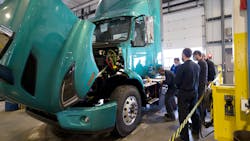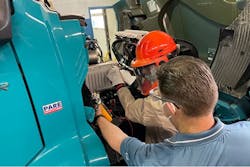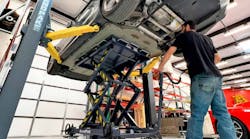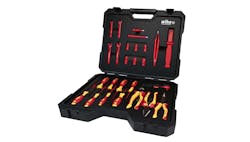Commercial electric vehicles are different than those with internal combustion engines. Radically different. Their drive systems are quieter and simpler (with significantly fewer moving parts), their lithium-ion batteries are almost alien objects to many traditional technicians, EVs weigh much more (with a lot of that weight contained in their in-chassis batteries), and their lift points can be different than an ICE (internal combustion engine) truck. Put a Class 8 electric on a lift solely meant for an ICE tractor and the damage easily could run in the thousands—if not tens of thousands—of dollars.
These differences present maintenance operators at fleets and dealerships with repair and tooling challenges and shop managers with maybe the tougher task of ensuring their technicians are trained to spot problems on EVs, fix them, and guard uptime just as vigorously as they would with any truck in their shop that burns diesel fuel or gasoline. All while doing so safely, away from electric shock hazards.
See also: Planning electrification could take fleets years, report finds
There are many important questions to consider as fleets begin their electrification journey—questions at least as important as electric-vehicle range, or use case, or charging availability and infrastructure sourcing or construction—having to do with how to keep EVs on the road. These issues have to do with people just as much as with tools and equipment required to maintain and repair electrics.
Fleet outsourcing of maintenance for their incoming battery-electric vehicles (BEVs) is an obvious answer, or leaning on a certified electric-vehicle dealership is another solution. But what if a fleet is getting into the EV business and has chosen to be in the EV maintenance business as well?
Dealers or fleet operators “need to begin thinking about changes they may need to make to their service shops to work on the high-voltage batteries that power BEVs,” Mike Roeth, executive director of the North American Council for Freight Efficiency, wrote in a column for FleetOwner. NACFE is a leading tester of sustainable fleet solutions, most notably operating the Run on Less–Electric trials and assessing the suitability of EVs in commercial applications. In doing so, Roeth and his people at NACFE have gathered insight on how EVs will need to be maintained and repaired.
“Will they designate a specific area in their existing shops for BEV service—or will they erect a separate building solely dedicated to working on BEVs? There is no right or wrong answer, but facilities' questions need to be answered.”
And, of course, Roeth added, there will be the need to make sure technicians are properly trained to work on these vehicles efficiently and safely.
Lock-out/key-out procedures will need to be developed to make sure the high-voltage batteries are disabled before work begins on any BEV. While technicians will see some components in EVs they are familiar with, such as tires and brakes, they will need to be trained in servicing the components that are unique to the all-electrics, he remarked. An EV's regenerative braking system is all-new, for example, and unique to electrics, so techs have to familiarize themselves with it.
“There is no consensus on how many fewer components the BEVs will have when compared to internal combustion vehicles, but we can all agree there will be fewer moving parts in a BEV," Roeth noted. "Some portion—in many cases a big portion—of a dealer’s profits come from parts and service. Dealers need to begin thinking about how they are structured and what changes they may need to make in their operating model to stay relevant as we transition to a zero-emission future.”
He noted that the Technology & Maintenance Council (TMC) of American Trucking Associations also is working on ongoing recommended best practices for servicing BEVs safely and efficiently.
To work on an EV, it often must be lifted
Some things with maintaining and repairing vehicles are elemental. That includes EVs.
For example, to maintain or repair anything, you often have to lift it in the air in a repair bay, meaning lift manufacturers are on the front lines of the switchover to electric vehicles in the commercial vehicle space. Some specs are specific to EVs, presenting a challenge for lift manufacturers.
Carl Boyer, Midwest regional sales manager for state-of-the-art lift maker Stertil-Koni, recently spoke with Fleet Maintenance, a sister publication to FleetOwner, saying: “We’re always kind of surprised that the customer hasn’t considered things like, ‘What's the wheelbase of my vehicles? What do they weigh?’ Typically, they want to maximize their lift to get the widest variety of vehicles on the lift.”
See also: TMC taking EV maintenance to task (forces) at annual meeting
Though the job of a lift remains the same whether it’s lifting an EV or ICE vehicle, the equipment needed to lift each type varies quite a bit. When it comes to EVs, they are much heavier than the average car. With the battery alone weighing around 1,000 lb., EV lifts must have an increased lifting capacity. Aside from the weight of the battery, its location has also created a need for lift modifications.
“The lift market is expanding to meet unique EV needs,” Brian Spikes, VP and GM with another manufacturer, Challenger Lifts, also told Fleet Maintenance. “OEs have made lifting points more specific to accommodate delicate wiring and EV battery locations.”
The committee’s eventual work product may be either an information report, which would take about a year to produce, or a proposal for a recommended practice, which could take about two years to produce. “In general, you need to be looking at dealing with control circuitry, battery maintenance, charger maintenance, control systems that involve electronics, and high-voltage circuits,” Legler said.
The National Institute for Automotive Service Excellence (ASE) also has created Electric Vehicle Technician/Shop Personnel Electrical Safety Standards. These standards will provide guidance and documentation as well as establish electrical safety requirements, standards, procedures, and safe work practices relating to the development of an electrically safe working area for service professionals working on or around EVs. These standards were developed in conjunction with vehicle manufacturers, aftermarket personnel, and other electric industry subject-matter experts, ASE stated in a release.
“Technicians and service personnel must be properly trained to perform EV service and repairs,” ASE President Tim Zilke added. “The new ASE EV testing and certification program was developed in conjunction with industry experts to help ensure that service professionals are well-prepared to safely and effectively service these technologically advanced vehicles.”
These standards include coverage of the risks associated with electric vehicle repair, how to help someone injured due to high voltage, various protective equipment, the training necessary to establish a safe workspace, how to handle high-voltage batteries and de-energize electric systems, and what types of testing instruments and equipment should be on hand as well as their inspection and usage.
Critical OEM investments in training
OEMs themselves also are investing in training to help prepare technicians. Last April, Daimler Truck North America expanded its Detroit Service Training Center, which will be used to train technicians in electric powertrain service, battery maintenance, and full truck repair.
“For the trucking industry to successfully transition to zero-emission vehicles, technicians need to know how to diagnose, service, and maintain new technology in order to keep our valued customers running with maximum uptime,” said Matt Pfaffenbach, head of operations at Detroit Powertrain.
Kenworth Truck also offers an EV technician training and certification program as part of its efforts to prep Kenworth dealerships to service EVs. As part of the program, Kenworth technicians must complete a seven-course curriculum on service systems, electrical principles, electrical systems, electrical systems II, cab and chassis electronics, electric vehicles systems, and advanced electric diagnostics.
See also: For those skeptical of EVs, Volvo offers ‘electromobility ecosystem’
While most EVs require the same tools for repair as an ICE vehicle since they still have tires, brakes, A/C systems, and other standard parts, technicians must have the right tools to service an EV battery, said Jennifer Grabowski, a product manager for Bosch.
In addition to capable lifts, a charging station in-house for servicing, as well as high-voltage gloves and insulated versions of existing tools, will become necessary. Technicians will also have to pay close attention to the CAT rating and the rating of tools when moving to EVs or hybrids. Knowing how to use a tool like a scope or a multimeter will go from a nice skill to have to a required one.
“Now, more than ever, regular training on new vehicle standards and specialty tools is the most beneficial way that fleet managers and technicians can ensure that they’re up to speed on new systems and able to address any issues that they may encounter when conducting diagnostics or a repair,” said Duane “Doc” Watson, field service technical trainer for Bosch. “Technicians are challenged with new, complex systems that could potentially create problems that certain technicians have never encountered before.”
Just as important as the EV lift itself are the EV lift tables used for lowering the battery from the vehicle. Getting the vehicle off the ground is just step one; shops need additional EV lift accessories, such as Stertil-Koni’s SKTJ Hydraulic Transmission Jack, to finish the job.
Added Tim Kerr, engineering sales support manager for Stertil-Koni: “What we have right now is actually a transmission jack, that's on swivels, and it has its own hydraulic piston that would come up to meet the batteries, and then lower [them] down safely.”
Kerr noted that Stertil-Koni is looking to potentially add a large battery table to the jack, and with the equipment’s 3,500-lb. capacity, it would be able to handle lifting and lowering any EV battery.
Another lift maker, BendPak, is coming to market with products specifically geared toward EVs of all sizes. The BendPak Mobi-EVS EV battery and powertrain lifting system family includes the upgraded EV2400SL and the new EV4000SL.
“Mobi-EVS lift tables can handle high-voltage battery packs from a Tesla Model 3 to a Ford F-150 Lightning all the way up to a GMC Hummer EV1,” said Jeff Kritzer, president and CEO of BendPak. “They protect technicians by eliminating manual lifting, lowering and positioning of heavy battery packs, and making it easy to ergonomically move them around the shop.”
For techs operating around high voltage
The transition to EVs will bring added complexity. Technicians will need to have additional training and, of course, some tools that differ from those used to work on ICE vehicles. The stakes are much higher than a game of Operation.
“When we look at new electric vehicles, some of the skills are basic, and technicians will need foundational skills. Since we’re dealing with higher voltages, there are safety aspects, and you will need tools to handle that current. But if technicians don’t possess the skills currently with a vehicle with an internal combustion engine, they won’t get smart overnight,” George Arrants, VP of the ASE Education Foundation, told Fleet Maintenance.
Working on any high-voltage systems requires specific and specialized tools as well, according to FleetOwner sources. Grabbing off-the-shelf screwdrivers or wrenches won’t do when working around high voltage. Specialized tools insulated for high voltage, ones that are rated for up to 1,000 volts and made of a nonconductive material, such as plastic, or coated with insulation against shock, become necessary.
See also: Voltera, Amerit to bring EV maintenance support to charging facilities
Care also must be taken with these tools to ensure that their insulative properties are not compromised. Tossing them in with the rest of the tools in a toolbox can cause abrasions or cuts to the insulation, allowing electricity to flow through them and into the unsuspecting technician.
TMC’s Technician and Educator Committee Electrified Vehicle Technician Training Task Force is evaluating the need for training guidelines to support electric commercial vehicle fleet maintenance operations and for training requirements for EVs in technician school curriculum programs. “That could mean refining existing training or creating completely new training,” Jack Legler, TMC’s technical director, also told Fleet Maintenance.
One challenge that technicians might endure is difficulty when trying to duplicate a problem with a truck, Watson said. “This is because EMI waves penetrate wiring and interfere with internal signals, which sometimes only happens under certain conditions and cannot always be replicated in the shop,” he explained. “It doesn’t mean that there isn’t an issue with the vehicle. It means that figuring out the issue will be more complex and uncommon.”
Because of the high voltage associated with EVs, technicians will need to learn how EVs operate and the safety steps to be taken before diving into diagnostics and repair. Lee Lackey, product manager at Noregon Systems, warned: “Electric truck batteries can be lethal and should be treated as such. Fleets and service centers must ensure any technician working on an EV is certified to do so while also dedicating certain bays to EVs and only allowing certified technicians in those bays.”
This story was a joint collaboration between Fleet Maintenance, FleetOwner.com, and VehicleServicePros.com.



